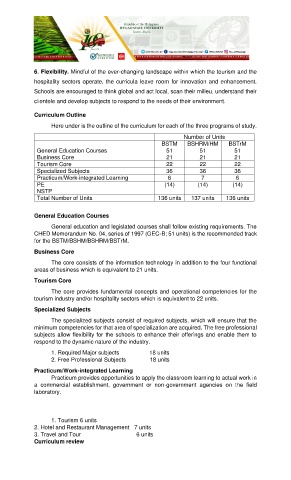Page 218 - Area III CURRICULUM AND INSTRUCTION
P. 218
6. Flexibility. Mindful of the ever-changing landscape within which the tourism and the
hospitality sectors operate, the curricula leave room for innovation and enhancement.
Schools are encouraged to think global and act local, scan their milieu, understand their
clientele and develop subjects to respond to the needs of their environment.
Curriculum Outline
Here under is the outline of the curriculum for each of the three programs of study.
Number of Units
BSTM BSHRM/HM BSTrM
General Education Courses 51 51 51
Business Core 21 21 21
Tourism Core 22 22 22
Specialized Subjects 36 36 36
Practicum/Work-integrated Learning 6 7 6
PE (14) (14) (14)
NSTP
Total Number of Units 136 units 137 units 136 units
General Education Courses
General education and legislated courses shall follow existing requirements. The
CHED Memorandum No. 04, series of 1997 (GEC-B; 51 units) is the recommended track
for the BSTM/BSHM/BSHRM/BSTrM.
Business Core
The core consists of the information technology in addition to the four functional
areas of business which is equivalent to 21 units.
Tourism Core
The core provides fundamental concepts and operational competencies for the
tourism industry and/or hospitality sectors which is equivalent to 22 units.
Specialized Subjects
The specialized subjects consist of required subjects, which will ensure that the
minimum competencies for that area of specialization are acquired. The free professional
subjects allow flexibility for the schools to enhance their offerings and enable them to
respond to the dynamic nature of the industry.
1. Required Major subjects 18 units
2. Free Professional Subjects 18 units
Practicum/Work-integrated Learning
Practicum provides opportunities to apply the classroom learning to actual work in
a commercial establishment, government or non-government agencies on the field
laboratory.
1. Tourism 6 units
2. Hotel and Restaurant Management 7 units
3. Travel and Tour 6 units
Curriculum review

